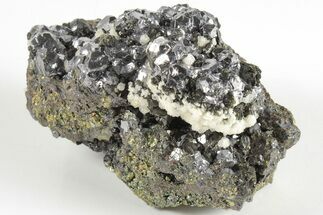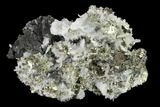This Specimen has been sold.
3.5" Pyrite, Sphalerite & Quartz Crystal Association - Peru
This is a beautiful cluster of pyrite and quartz crystals that formed in association with sphalerite. It comes from the Huanzala Mine in Peru and the entire specimen measures 3.5" wide.
Pyrite (or iron pyrite) is commonly referred to as Fool's Gold because its metallic luster and pale brass-yellow hue give it a superficial resemblance to gold. In the old mining days, Pyrite was sometimes mistaken for gold. Pyrite is the most common of the sulfide minerals with the chemical formula FeS2. Pyrite crystals occur in many shapes and habits. Smaller (druzy) crystal aggregates may give off beautiful glistening effects, and larger crystals may be perfectly formed, including fascinating cubes, penetration twins, and other interesting crystal forms.
Sphalerite is a part of the sulfide group and typically exhibits a grey/black appearance due to high concentrations of impurities. In its purest state, sphalerite's chemical composition is ZnS, and can display a gemmy transparent light tan/yellow color. This is one of the few minerals that can form crystals ranging anywhere between gemmy and transparent to opaque and metallic-like. Opaque or cloudy sphalerite tends to be most abundant since iron easily replaces zinc in the process of formation.
About Quartz
Quartz is the name given to silicon dioxide (SiO2) and is the second most abundant mineral in the Earth's crust. Quartz crystals generally grow in silica-rich environments--usually igneous rocks or hydrothermal environments like geothermal waters--at temperatures between 100°C and 450°C, and usually under very high pressure. In either case, crystals will precipitate as temperatures cool, just as ice gradually forms when water freezes. Quartz veins are formed when open fissures are filled with hot water during the closing stages of mountain formation: these veins can be hundreds of millions of years old.
Quartz is the name given to silicon dioxide (SiO2) and is the second most abundant mineral in the Earth's crust. Quartz crystals generally grow in silica-rich environments--usually igneous rocks or hydrothermal environments like geothermal waters--at temperatures between 100°C and 450°C, and usually under very high pressure. In either case, crystals will precipitate as temperatures cool, just as ice gradually forms when water freezes. Quartz veins are formed when open fissures are filled with hot water during the closing stages of mountain formation: these veins can be hundreds of millions of years old.
SPECIES
Pyrite, Sphalerite & Quartz
LOCATION
Huanzala Mine, Bolognesi, Peru
SIZE
3.5" wide
CATEGORY
SUB CATEGORY
ITEM
#136214
 Reviews
Reviews













